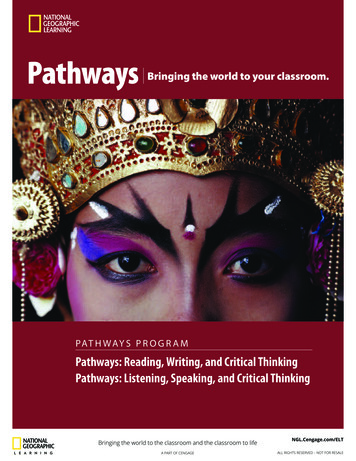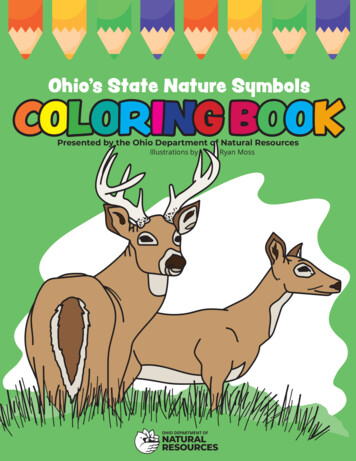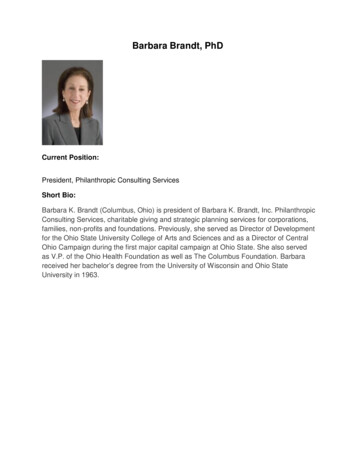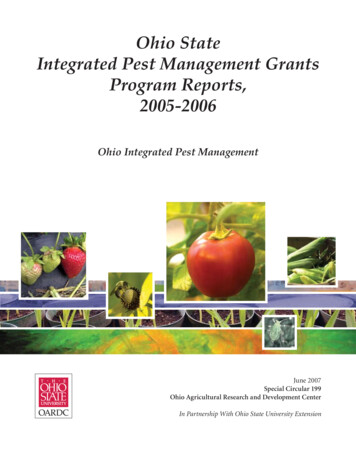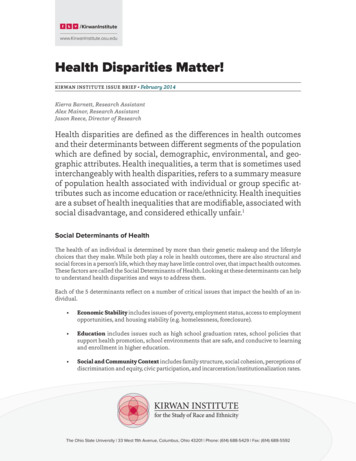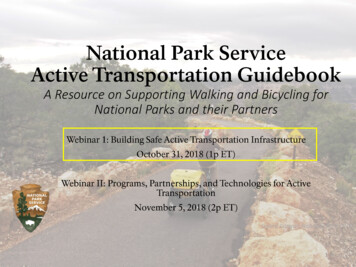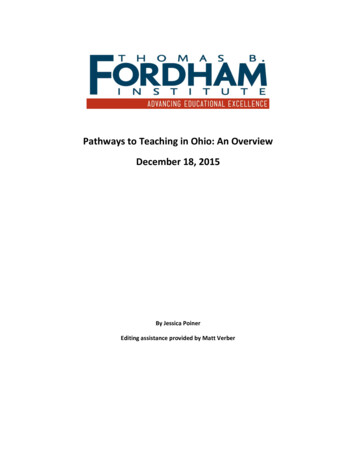
Transcription
Pathways to Teaching in Ohio: An OverviewDecember 18, 2015By Jessica PoinerEditing assistance provided by Matt Verber
INTRODUCTIONWhile it’s widely recognized that teaching a class full of children is a complex and demanding job, ateacher’s road to the classroom is less straightforward than many people think. The process of becominga teacher is different in every state and includes unique requirements, tests, and pedagogicalcheckpoints. Within each state, the traditional teacher pathway is also complemented by variousalternative pathways. In the past decade, for example, Ohio has expanded the opportunities available toaspiring teachers who haven’t attended a traditional teacher preparation program but want to teach inOhio schools. Each pathway, traditional or alternative, has both shared and distinctive requirements.This paper provides an in-depth examination of each of Ohio’s teacher pathways.TRADITIONAL TEACHER PREPARATION PROGRAMSChoosing a programAs of 2014, the Ohio Department of Education acknowledges fifty-six education schools: thirteen publicinstitutions and forty-three private ones.1 Each of these institutions must be approved by the OhioDepartment of Higher Education before they are permitted to educate teacher candidates, and existingprograms are reviewed every seven years.In an effort to share information with the public and potential teacher candidates, the Ohio Departmentof Higher Education and the Ohio Department of Education offer yearly performance reports that sharedata on teacher preparation programs such as licensure test scores, value-added numbers, and educatorsurveys. However, there are no minimum requirements that programs must reach, nor are thereconsequences for a program’s low performance.Getting acceptedEntry requirements on a candidate level are left up to individual institutions.2 Many institutions requirea minimum GPA, though whether this is a candidate’s high school GPA or their college GPA prior toapplication, as well as the specific GPA required, varies based on the institution.CourseworkTeacher candidates are required by state law to receive certain experiences and coursework during thecompletion of their education degree.3 While programs differ in the delivery of coursework andexperience requirements, schools are required to align their courses and other student experiences withthe following components:1. The Ohio standards for the teaching profession, which outline the basic expectations for Ohioteachers42. Coursework in the teaching of reading and phonics if the license is designated for teachingchildren in grades K–65Pathways to Teaching in Ohio: An OverviewPage 2
3. Preparation in implementing evidence-based instructional strategies addressing individuallearner differences, and employing practices that address diversity4. Specialized national professional association standards or state standards5. The Ohio academic content standards and curriculum models adopted by the state board ofeducation6. Minimum standards for elementary and secondary schools67. The value-added progress dimension8. A minimum of twelve weeks of full-time student teaching and a minimum of one hundred clockhours of field experiences prior to student teachingIn addition to what is required by law, teacher candidates typically complete classes that focus on areassuch as classroom technology, assessments and data, and teaching strategies. Candidates also takecourses based on the age group and subject area(s) they plan to teach. These courses are designed byeach college of education.LICENSURE PROCESS FOR TRADITIONAL CANDIDATESLicensure testsTeacher candidates must pass a series of tests before they can obtain a license that permits districts tohire them full-time. In the past, Ohio teacher candidates have taken Praxis II exams7 to determinewhether they are qualified to receive teaching licenses. Beginning in September 2013, the OhioAssessments for Educators (OAE)8 began to replace most Praxis II exams. The new assessments aredesigned to serve the same purposes as Praxis II exams: to measure professional, pedagogical, andsubject-specific knowledge and skills.9 They are also aligned to Ohio’s Learning Standards.10Teacher candidates are required to earn passing scores on one assessment of pedagogical knowledgeand content tests associated with each content area they intend to teach.11 For example, a teachercandidate who wished to teach high school English language arts would need to pass the Assessment ofProfessional Knowledge: Adolescence to Young Adult (a pedagogy assessment that covers grades 7–12)as well as the English language arts content test.There are, however, exceptions. For instance, mild-to-moderate-needs special education teachercandidates are not currently required to take content tests; instead, in addition to their pedagogy test (amulti-age test), they take a test that assesses their knowledge of special education as a whole. Similarly,early childhood education (PK–3) teachers are required to take a test that assesses their knowledge ofearly childhood education rather than specific content knowledge.Resident Educator LicenseThe Ohio Revised Code lists several requirements that a prospective teacher must meet in order to beissued an initial license.12 These requirements state that a candidate must:1. Hold a bachelor’s degree from an accredited institution of higher educationPathways to Teaching in Ohio: An OverviewPage 3
2.3.4.5.6.Successfully complete an approved program of teacher preparationBe deemed to be of good moral characterSuccessfully complete the examinations prescribed by the state board of educationDemonstrate skill in integrating educational technology in the instruction of childrenBe prepared to implement evidence-based instructional strategies addressing individual learnerdifferences and diversity in culture, language, origins, and community7. Be recommended by the dean or head of teacher education at an institution approved toprepare teachers8. If the applicant plans to teach children in grades K–12 or the equivalent, additional courseworkin the teaching of reading is required13Once a teacher candidate has met these requirements, he or she can apply for a teaching license.While there are several types of licenses in Ohio,14 a brand-new teacher applies for a ResidentEducator License. This is a four-year license that may be used for full-time or substitute teaching.The Resident Educator License is renewable and serves as the stepping stone to advanced licenses. 15Overall, the pathway to a Resident Educator License looks something like this:Passedlicensure examsDemonstartedskill ineducationaltechnologyGood chelor'sdegreeKnowledge by head k inteachingreadingLicense differentiationEach license—whether initial or advanced—is differentiated based on the grade level of the studentswho will be taught.16 These divisions are:Pathways to Teaching in Ohio: An OverviewPage 4
1. The early childhood license, which covers grades PK–3. This license requires a minimum oftwelve hours in the teaching of reading.2. The middle childhood license, which covers grades 4–9. This license requires preparation in thehumanities in addition to areas of concentration in two of the following: reading and languagearts, math, science, and social studies. A minimum of twelve hours in the teaching of reading isrequired regardless of concentration areas.3. The adolescence to young adult license, which covers grades 7–12. This license requires anacademic major with advanced coursework in all areas to be taught and a minimum of threesemester hours in the teaching of reading in the content areas. Licenses are issued in thefollowing disciplines: earth sciences, integrated language arts, integrated math, integratedscience, integrated social studies, life sciences, and physical sciences.4. The multi-age license, which covers pre-K through twelfth grade. This license requires anacademic major of advanced coursework in all areas that will be taught, along with a minimumof three hours in the teaching of reading. Licenses are issued in the following disciplines:computer science, bilingual education, dance, drama/theater, foreign language, health,library/media, music, physical education, teaching English to speakers of other languages, andvisual arts.Licenses for intervention specialists and career-technical instructors are also available. Special educationteaching candidates are not differentiated by subject or grade level.Resident Educator Program and RESAIn order to progress to a license more advanced than the Resident Educator License, teachers mustcomplete four years in the Resident Educator Program.17 This program provides support to new teachersthroughout their first four years, including mentorship, collaboration with veteran educators,professional development, and formative assessment feedback.In addition to completion of the program, teachers must also pass the Resident Educator SummativeAssessment (RESA). RESA is a performance-based assessment that requires a teacher to submit online aportfolio of evidence and completed tasks. The assessment measures a teacher’s ability to design anddeliver instruction that is engaging, emphasizes higher-order thinking, and uses data to drive practice.18RESA is intended as a summative assessment for teachers in their third year of the Resident EducatorProgram, but a district or school has discretion over when its teachers take the test. A teacher’s RESAsubmission is scored on a rubric that is aligned to the Ohio Standards for the Teaching Profession.Teachers may register to re-take any failed portion of the RESA.Advanced LicensesOnce teachers complete the Resident Educator Program, successfully pass RESA, and reach the end oftheir four-year Resident Educator License, they must apply for a five-year, renewable ProfessionalLicense. There are two additional options available for teachers who wish to advance their license pastthe Professional License.19Pathways to Teaching in Ohio: An OverviewPage 5
1. Senior Professional Educator License: This five-year, renewable license requires that theapplicant: Have a master’s degree or higher from an accredited institution Have nine years of experience, at least five of which must be under a professionallicense Have successfully completed the Master Teacher portfolio. The portfolio requires that acandidate submit written explanation and evidence of five criteria: consistentleadership; focused collaborative efforts; a focus on students and environment; a focuson content, instruction, and assessment; and continued professional growth.20Applicants must achieve exemplary scores in four of the five areas on the rubric, which are thencompared to determine a final score. The applicant must also submit two signedrecommendation forms.21 If the applicant is successful, the Master Teacher designation can berenewed via a process that requires submitting written reflections and evidence.2. Lead Professional Educator License: This five-year, renewable license has the samerequirements as the Senior Professional Educator License, with an additional requirement: Theapplicant must hold active National Board Certification or must successfully complete theMaster Teacher portfolio and the Teacher Leader Endorsement.22 This endorsement is valid formentoring and coaching teachers, providing staff development, and assisting the principal. TheTeacher Leader Endorsement is available through many graduate education programs andincludes a practicum experience which requires teachers to demonstrate their knowledge andskills.ALTERNATIVE PATHWAYS TO LICENSUREAlternative Resident Educator LicenseOhio Revised Code permits four-year Alternative Resident Educator Licenses for grades K–12 to beissued to applicants who meet the following requirements:231. Hold a bachelor’s degree from an accredited institution2. Completed a minimum of twenty-four semester hours of coursework (including advancedcoursework) in the subject area they plan to teach, with a GPA of at least 2.5-ORIf pursuing an integrated social studies, integrated language arts, or integrated science license,candidates must have completed forty-eight semester hours of coursework (including advancedcoursework) in the subject area to be taught, with a GPA of at least 2.5. Integrated language artsteachers must include six semester hours in the area of teaching reading as part of their totalhours.Pathways to Teaching in Ohio: An OverviewPage 6
3. Successful completion of required teacher licensure exams, such as content exams for thesubjects to be taught4. Pass required background checks245. Successfully complete the Intensive Pedagogical Training Institute or a summer instituteapproved by the chancellor of the Ohio Department of Higher EducationAlternative licenses are available for designated subjects in grades K–12, world languages in grades PK–12, intervention specialists for grades K–12, Montessori education, and career-technical workforcedevelopment.25 Candidates for the career-technical workforce development alternative license are notrequired to hold a bachelor’s degree, but they must have experience in the career area to be taught.26In order to maintain licensure, teachers must participate in the Resident Educator Program, successfullycomplete at least twelve additional hours of professional education coursework from a college oruniversity in specified areas, and successfully complete RESA. Teachers with Alternative ResidentEducator Licenses are permitted to pursue advanced licenses such as the Professional Educator License.Intensive Pedagogical Training InstituteThe Intensive Pedagogical Training Institute (IPTI) provides nontraditional teacher candidates withinstruction in the principles and practices of teaching.27 Teachers who wish to obtain an alternativelicense must apply and complete IPTI in order to receive an alternative license.28 IPTI includes threeonline, self-paced modules that focus on teaching as a profession, student development and learning,and the essentials of teaching practice. Participants must also complete twenty-five hours of fieldexperience. Participants are responsible for locating a site for their field experience, and acceptable sitesinclude public schools, private schools, before- and after-school programs, summer school, studentintervention programs, camps, and for some applicants, preschools.29 In some cases, substitute teachingmay also meet the field experience requirement. The site must be approved by an IPTI instructor.Aspiring teachers must complete all the modules and their field experience within six months of theiracceptance into the IPTI; the deadline cannot be extended.30 All assignments in IPTI require a proficientrating, which is achieved by a minimum of 80 percent mastery. The fee for IPTI is 200.31Teach For AmericaTeach For America (TFA) is a national teacher corps of recent college graduates and professionals whocommit two years to teaching in an under-resourced urban or rural public school.32 TFA operates tworegional offices in Ohio: one in southwest Ohio that serves schools in Cincinnati, Dayton, and a smallportion of Kentucky; and a second in northeast Ohio that serves schools in the Cleveland area. TFA is astandalone program that is not affiliated with the Ohio Department of Higher Education.TFA teachers, called corps members, are not required to attend a traditional teacher preparationprogram. Instead, they are assigned to teach subject areas and grade levels based on qualifications suchas their GPA, college major, and college coursework.33 In Ohio, TFA corps members are required to holda bachelor’s degree, must have a GPA of 2.5 or higher, and must pass the corresponding licensure exams(including content and pedagogy exams) for each subject area they intend to teach.34 In addition, corpsPathways to Teaching in Ohio: An OverviewPage 7
members must successfully complete TFA’s summer institute35 and maintain their status as members ofTFA. The state board of education is required to revoke the license of any corps member who resigns oris dismissed from TFA.36 TFA is required to reach agreements with one or more accredited four-yearhigher education institutions to provide optional training for corps members with the purpose ofallowing them to complete their master’s degree. However, the completion of a master’s degree is not arequirement of Ohio licensure or the TFA program.If a corps member completes their two year commitment in another state and then moves to Ohio withthe intent of teaching, the state board of education is required to issue that corps member a ResidentEducator License and credit them as having completed two years of the Resident Educator Program.37OUT-OF-STATE TEACHERSTeachers from out of state are permitted to obtain a license to teach in Ohio if they meet certainguidelines.38 Applicants are required to have: Proof of an out-of-state teaching license or a letter of eligibility signed by the head or dean of ateacher education program Verification of any out-of-state licensure exams Verification of experience (if the applicant has three or more years of experience) An official transcript A record of any coursework completed outside the United StatesApplicants must also complete background checks. Out-of-state teachers who completed a Praxis testfor licensure before September 3, 2013 may use their Praxis results to satisfy licensure testingrequirements.39 Otherwise, all applicants must take any applicable Ohio Assessments for Educatorstests.Pathways to Teaching in Ohio: An OverviewPage 8
ENDNOTES1Ohio Department of Higher Education, 2014 Ohio Educator Performance Reports, accessed January 6, ability/2014-performance-reports.2Ohio Revised Code § 3301-24-03.3Ibid.4Ohio State Board of Education, Standards for Ohio Educators, accessed January 6, s/StandardsforEducators revaug10.pdf.aspx.5Ohio Revised Code § 3319.24.6Ohio Revised Code § 3301-35.7Educational Testing Service, Praxis II Overview, accessed January 6, hio Assessments for Educators, Assessments, accessed January 6, 2015,http://www.oh.nesinc.com/PageView.aspx?f GEN Tests.html.9Ohio Department of Education, Educator License Exams, accessed January 6, ucatorLicensure-Examinations.10Ohio Department of Education, Ohio’s New Learning Standards, accessed January 6, hio Assessments for Educators, “What Assessments Do I Need to Take?,” accessed January 6, AssessmentsDoINeedtoTake.pdf.12Ohio Revised Code § 3301-24-18.13Ohio Revised Code § 3319.24.14Ohio Department of Education, Teacher License Overview, accessed January 6, ator-LicenseTypes-and-Descriptions.15Ohio Department of Education, “How to extend, advance or renew a resident educator or alternative residenteducator license,” accessed January 6, 2015, advance-or-renew-a-resident-educator.16Ohio Revised Code § 3301-24-05.17Ohio Department of Education, Resident Educator Program Overview, accessed January 6, 18Ohio Department of Education, Resident Educator Summative Assessment (RESA), accessed January 6, Assessment-RESA.19Ohio Revised Code § 3319.22.20Ohio Department of Education, Master Teacher Application, accessed January 6, C mtapplication RevMar18lskm.pdf.aspx.21Ohio Department of Education, Master Teacher Candidate Recommendation Form, accessed January 6, /G OhioMT-rec-Form-21108 finalsept09.pdf.aspx.22Ohio Revised Code § 3301-24-05.23Ohio Revised Code § 3301-24-19.24Ohio Attorney General, Background Check, accessed March 19, usiness/WebCheck/Webcheck-Community-Listing.25Ohio Department of Education, Intensive Pedagogical Training Institute FAQs, accessed March 19, -Training-Institute-FAQs#FAQ688.Pathways to Teaching in Ohio: An OverviewPage 9
26Ohio Department of Education, Four-Tiered Teacher Licensure Structure, accessed March 19, Ohio Department of Education, Intensive Pedagogical Training Institute (IPTI) Syllabus, accessed March 19, llabus-REVISED-12-1.pdf.aspx.28Ohio Department of Education, Intensive Pedagogical Training Institute (IPTI) Registration Form, accessed March19, 2015, I-Registration-Form-6-2014-pdf.pdf.aspx.29Ohio Department of Education, Intensive Pedagogical Training Institute FAQs, accessed March 19, ach For America, accessed March 19, 2015, https://www.teachforamerica.org/.33Teach For America, How We Place Corps Members, accessed March 19, orpsmembers.34Ohio Department of Education, Four-Tiered Teacher Licensure Structure, accessed March 19, Teach For America, Summer Training, accessed March 19, 2015, ca/training-and-support/summer-training.36Ohio Revised Code § 3319.227.37Ibid.38Ohio Department of Education, Out of State Licensure, accessed March 19, cator-Licensure/Out-of-State-Licensure.39Ohio Department of Education, Educator Licensure Testing Requirements as of January 1, 2015, accessed March19, 2015, suretestchart.pdf.aspx.Pathways to Teaching in Ohio: An OverviewPage 10
Alternative Resident Educator License Ohio Revised Code permits four-year Alternative Resident Educator Licenses for grades K-12 to be issued to applicants who meet the following requirements:23 1. Hold a bachelor's degree from an accredited institution 2. Completed a minimum of twenty-four semester hours of coursework (including advanced
